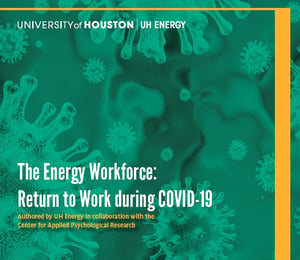To download the full study, go here. To read the executive summary, read below.

Background and Methodology
Low oil prices and the onset of COVID-19 cases in the United States have depressed energy demand and has dramatically altered the employment situation for almost all energy workers: A majority of energy workers who usually work in office settings worked from home. At this point (early May 2020), companies are starting the return to a new, unprecedented normal. UH Energy has partnered with PESA, the Petroleum Equipment and Services Association; Pink Petro, which focuses on advancing women and environmental challenges facing the industry; IPAA, the Independent Petroleum Association of America and the Energy Management Institute at Texas A&M University – to gather data on expectations for the return to work from
448 energy workers from April 27, 2020, to May 5, 2020. 81% of those surveyed usually work from an office. 11% had been laid off or furloughed. The rest of the respondents are either working in the field/off-shore or in another capacity. Analyses reported here focus on employees who had been working from home since mid-March 2020.
Highlights
- Access to testing continues to be a concern for energy workers. Moreover, pre-existing conditions put almost a quarter of the surveyed energy workers at risk of complications from COVID-19. 6.6% of respondents had experienced COVID-19 symptoms but reported they were unable to obtain testing. Three respondents tested positive for COVID-19. Among energy workers, approximately 25% indicated they had been diagnosed with pre-existing conditions that put them at an increased risk of complications from COVID-19.
- Over 70% of workers indicated they would prefer to continue working from home if their office reopened the next month. When asked separately about a furlough option, 20% were willing to take an unpaid furlough to avoid a physical return. Employees who had concerns about childcare reported a higher reluctance to return. Energy workers living in multi-generation households were more concerned about returning to work than others. Older workers and workers with long industry tenure were more likely to want to return to work than younger workers. In terms of workplace factors, if employees believed their supervisors would effectively work to mitigate COVID-19 infections, they were less reluctant to return.
- Employees who were confident that their employers would implement enhanced cleaning protocols and would provide PPE were less concerned about the return to work than employees who did not feel PPE would be provided or supplemental cleaning would be put in place. Employees generally expected a phased return to work, but did not expect to see resources available to quarantine exposed employees or undertake elective electronic contact tracing protocols.
- Respondents reported continued good physical health. Only a small number noted that their physical health was impaired in the last 30 days. In contrast, mental health issues were prevalent, with total health impairment over the last 30 days exceeding pre-COVID-19 national norms. Job insecurity and work-family interface issues predict mental health among energy workers during COVID-19.
Policy Implications of COVID-19
Workers’ perspectives regarding the return to their physical workspaces vary widely. But, the majority of workers are hesitant to return and would prefer the opportunity to continue working from home for at least the near-term future. Flexible policies accommodating worker perspectives are likely to be most effective in enhancing employee productivity and well-being.
Childcare concerns must also be addresses to avoid alienating parents, particularly wfemale energy workers. First-line supervisors’ strategies in mitigating workplace infections will play a critical role in addressing employee concerns about the return to work at the office. Employees living in multi-generation households may more urgently need dispensation from returning to their physical work environment. Interestingly, employees with pre-existing conditions were not more likely to want to continue working from home than others.
Securing access to PPE (masks, gloves, sanitizer) and providing PPE to employees, as well as implementing and communicating the presence of enhanced workspace cleaning protocols are likely to be effective organizational strategies in mitigating return concerns. If contact tracing is required and implemented wherein health and temperature scans are recorded, organizations should be prepared to carefully explain and communicate the rationale for their implementation and the efforts to ensure privacy.
Companies need to prioritize normalizing the discussion of mental health issues. HR departments and EAP programs may want to consider integrating first-line supervisors in efforts to identify employees who may need mental health support to prevent mental health issues from affecting long-term health and productivity.
Companies should address work-family conflict and job insecurity through flexible work arrangements and clear communication. This can function as another source of support for employees experiencing mental health issues.
The mental health demands of laid off energy workers requires further attention. They, in terms of mental health, have suffered the most during the COVID-19 pandemic. The energy industry is likely to undergo several more rounds of job cuts over the next few months. Therefore, employers should consider addressing mental health issues as part of the separation and reductions package.





